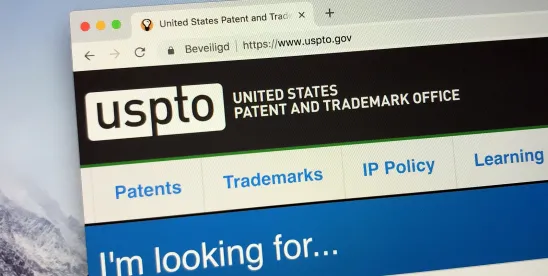On May 10, 2024, the US Patent & Trademark Office (PTO) issued a notice of proposed rulemaking (Notice) concerning major changes to the terminal disclaimer (TD) practice, which may lead to a sea change in patent prosecution strategies. The proposed change would require a TD to include an agreement from the patent owner that the patent will be unenforceable if it’s tied directly or indirectly to another patent having any patent claim invalidated or canceled based on prior art. 89 Fed. Reg. 40439 (May 10, 2024).
The rule change is a potential boon for patent challengers and is intended to promote innovation and competition by allowing a competitor to avoid enforcement of patents tied by TDs to patents with claims finally held unpatentable or invalid. Under current practice, invalidation of a patent tied to another patent by a TD does not directly affect the patentability of the other patent. Under the new rule, a competitor could target a single patent in a validity dispute in a post-grant challenge without the need to seek review and invalidation of other related patents. As a result, invalidating one claim in a patent tied to other patents by TDs would render all other tied patents unenforceable.
According to the Notice, the proposed change aligns with the US government’s intent to reduce drug costs and promote competition by reducing barriers to market entry in accordance with President Biden’s Executive Order 14036 on “Promoting Competition in the American Economy.” Part of the reduced costs are said to come from bringing down the cost of challenging large “patent thickets” of multiple patents covering a single product or minor variations of the product tied by TDs.
The proposed rule change would represent a paradigm shift for TD practice. Current TD practice under 37 CFR 1.321(c) or (d) allows applicants to file multiple patents with claims varying in only minor ways from one another by filing TDs to obviate obviousness-type double patenting (ODP) rejections over closely related patent claims issued or pending in applications commonly owned or commonly owned on the basis of a joint research agreement. In filing a TD, the applicant agrees to disclaim any patent term extending beyond the term of the prior patent having similar patent claims.
The proposed rule seeks “to revise 37 CFR 1.321 (c) and (d) to require that a terminal disclaimer filed to obviate nonstatutory double patenting include an agreement by the disclaimant that the subject patent or any patent granted on the subject application shall be enforceable only if the patent is not tied and has never been tied directly or indirectly to a patent by one or more terminal disclaimers filed to obviate nonstatutory double patenting in which:
(1) any claim has been finally held unpatentable or invalid under 35 U.S.C. 102 or 103 . . . by a Federal court in a civil action or by the PTO, and all appeal rights have been exhausted; or
(2) a statutory disclaimer of a claim is filed after any challenge based on 35 U.S.C. 102 or 103 to that claim has been made.” [Emphasis added.]
The proposed rule is prospective only and would not apply to patents containing TDs without the agreement language in the new TD. Further, the new TD practice only links patents directly one way. Therefore, while patent/application A may be directly tied to patent/application B by a TD filed in patent/application A, patent/application B is not tied to patent/application A. However, if in the foregoing scenario a second TD is filed in patent/application C identifying patent/application A as a reference patent or application, then patent/application C is tied indirectly to patent/application B. The Notice describes several examples illustrating scenarios in which patents may be directly or indirectly tied to one another by TDs and how the proposed rule would work in practice.
The proposed rule would have significant effects on prosecution. Adoption of the new rule would, for example, likely lead to:
- More arguments and amendments to overcome ODP rejections
- Cancellation of conflicting claims
- Less filing of continuation applications with only minor variations
- More filing of applications with an increased number of claims varying in degrees of scope to prompt restriction requirements and to obviate the need for more continuation filings
- Increased filing of divisional applications, which are not subject to ODP rejections in certain instances
- Filing of earlier applications in a family with narrower claims and progressively broadening claims in later-filed applications to reduce the risk of later-filed applications being invalidated over the earlier-filed applications.
The PTO has set a deadline of July 9, 2024, for comments to the proposed rulemaking changes. Some of the comments are expected to raise questions over the PTO’s statutory authority to enact the proposed changes, which may be ultimately resolved by the courts or Congress.
For further details, see the Notice in the Federal Register here.




 />i
/>i

